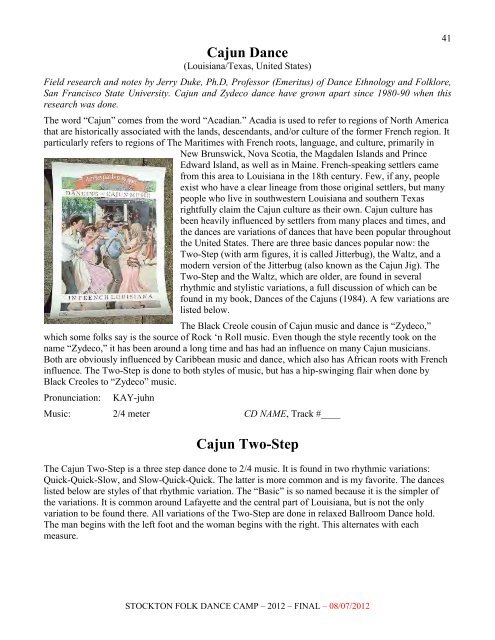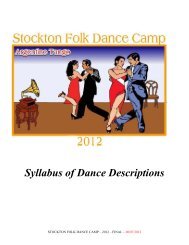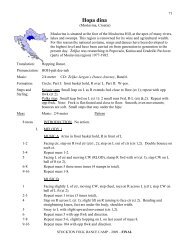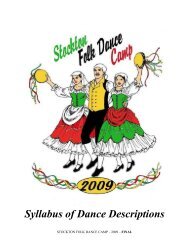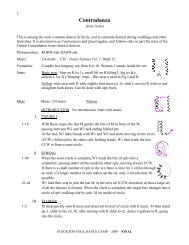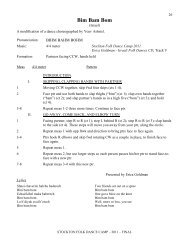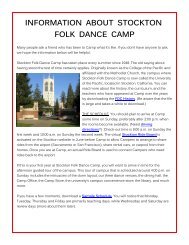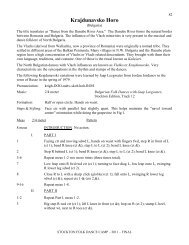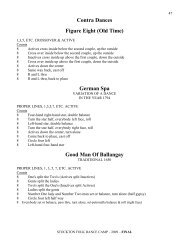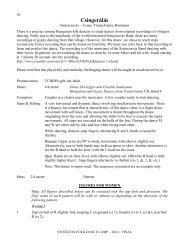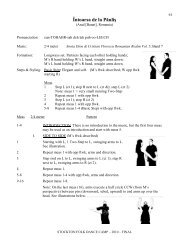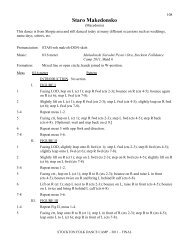Cajun Dance Cajun Two-Step - Stockton Folk Dance Camp
Cajun Dance Cajun Two-Step - Stockton Folk Dance Camp
Cajun Dance Cajun Two-Step - Stockton Folk Dance Camp
You also want an ePaper? Increase the reach of your titles
YUMPU automatically turns print PDFs into web optimized ePapers that Google loves.
<strong>Cajun</strong> <strong>Dance</strong><br />
(Louisiana/Texas, United States)<br />
Field research and notes by Jerry Duke, Ph.D, Professor (Emeritus) of <strong>Dance</strong> Ethnology and <strong>Folk</strong>lore,<br />
San Francisco State University. <strong>Cajun</strong> and Zydeco dance have grown apart since 1980-90 when this<br />
research was done.<br />
The word “<strong>Cajun</strong>” comes from the word “Acadian.” Acadia is used to refer to regions of North America<br />
that are historically associated with the lands, descendants, and/or culture of the former French region. It<br />
particularly refers to regions of The Maritimes with French roots, language, and culture, primarily in<br />
New Brunswick, Nova Scotia, the Magdalen Islands and Prince<br />
Edward Island, as well as in Maine. French-speaking settlers came<br />
from this area to Louisiana in the 18th century. Few, if any, people<br />
exist who have a clear lineage from those original settlers, but many<br />
people who live in southwestern Louisiana and southern Texas<br />
rightfully claim the <strong>Cajun</strong> culture as their own. <strong>Cajun</strong> culture has<br />
been heavily influenced by settlers from many places and times, and<br />
the dances are variations of dances that have been popular throughout<br />
the United States. There are three basic dances popular now: the<br />
<strong>Two</strong>-<strong>Step</strong> (with arm figures, it is called Jitterbug), the Waltz, and a<br />
modern version of the Jitterbug (also known as the <strong>Cajun</strong> Jig). The<br />
<strong>Two</strong>-<strong>Step</strong> and the Waltz, which are older, are found in several<br />
rhythmic and stylistic variations, a full discussion of which can be<br />
found in my book, <strong>Dance</strong>s of the <strong>Cajun</strong>s (1984). A few variations are<br />
listed below.<br />
The Black Creole cousin of <strong>Cajun</strong> music and dance is “Zydeco,”<br />
which some folks say is the source of Rock ‘n Roll music. Even though the style recently took on the<br />
name “Zydeco,” it has been around a long time and has had an influence on many <strong>Cajun</strong> musicians.<br />
Both are obviously influenced by Caribbean music and dance, which also has African roots with French<br />
influence. The <strong>Two</strong>-<strong>Step</strong> is done to both styles of music, but has a hip-swinging flair when done by<br />
Black Creoles to “Zydeco” music.<br />
Pronunciation: KAY-juhn<br />
Music: 2/4 meter CD NAME, Track #____<br />
<strong>Cajun</strong> <strong>Two</strong>-<strong>Step</strong><br />
The <strong>Cajun</strong> <strong>Two</strong>-<strong>Step</strong> is a three step dance done to 2/4 music. It is found in two rhythmic variations:<br />
Quick-Quick-Slow, and Slow-Quick-Quick. The latter is more common and is my favorite. The dances<br />
listed below are styles of that rhythmic variation. The “Basic” is so named because it is the simpler of<br />
the variations. It is common around Lafayette and the central part of Louisiana, but is not the only<br />
variation to be found there. All variations of the <strong>Two</strong>-<strong>Step</strong> are done in relaxed Ballroom <strong>Dance</strong> hold.<br />
The man begins with the left foot and the woman begins with the right. This alternates with each<br />
measure.<br />
STOCKTON FOLK DANCE CAMP – 2012 – FINAL – 08/07/2012<br />
41
42<br />
<strong>Cajun</strong>— continued<br />
Meas 2/4 meter Pattern<br />
I. BASIC (M begins with L; W with R) Rotate slowly as a couple either CCW or<br />
CW.<br />
1 <strong>Step</strong> in place (ct 1); hold (ct &); step bkwd with little or no turn of the body (ct 2);<br />
step in place (ct &).<br />
2 Repeat meas 1 with opp ftwk.<br />
II. BASIC WITH TRAVEL (M begins with L; W with R) Move as a couple, one<br />
partner fwd, the other bkwd.<br />
1 Small step fwd (or bkwd) (ct 1); hold (ct &); large step in the same direction (ct 2);<br />
small step in opp direction (ct &).<br />
2 Repeat meas with opp ftwk.<br />
III. PORT ARTHUR (TX) SPECIAL (Similar to BASIC but with twisting feet)<br />
1 Wt on both ft, twist heels inward (ct 1); lift one ft (M’s R; W’s L), while twisting<br />
heels outward (ct &); step bkwd while twisting heels inward, with an optional kick<br />
down and fwd with the free ft (ct 2); step into original place while twisting heels<br />
outward (ct &).<br />
2 Repeat meas with opposite ftwk.<br />
<strong>Cajun</strong> <strong>Two</strong>-<strong>Step</strong> Common Arm Figures<br />
When arm figures are done with the “Basic” or the “Port Arthur” styles, the dance is called “Jitterbug.”<br />
Arm figures are started on ct 1, finished by ct 2, and are followed by the steps found in “Basic” ct 2, &.<br />
Arm figures are done from the double handhold position (M and W facing, holding opp hands between)<br />
except for “Outside Arch Under,” which is also done from the Ballroom position.<br />
Outside Arch Under: Done from Ballroom position. Can be done on ct 1 of any measure, but usually on<br />
meas 1. M guides W under uplifted L holding W’s R. W steps fwd and turns R to face M while M steps<br />
fwd and turns L to face W. Both turn approximately one-half.<br />
Inside Arch Under: Done from Ballroom position. Can be done on meas 2 following an “Outside Arch<br />
Under,” or on ct 1 of any meas. M guides W across in front of him with uplifted L arm holding W’s R<br />
while changing places. W steps fwd and turns L to face M as M steps fwd and turns to R to face W.<br />
Brush-Off: Done from the double handhold position. More easily done on meas 1, ct 1. M brings L arm<br />
in front level with his waist to guide W to his R side while stepping fwd and turning half L away from<br />
W, releasing handhold. M continues to turn to face W while she turns either direction to face him (the<br />
man usually guides her turn direction).<br />
There is a different <strong>Cajun</strong> Jitterbug (also known as <strong>Cajun</strong> Jig) which is done with a buzz step. It most<br />
likely came from what I learned as the Mexican Merengue (which may have come from Polish settlers<br />
in northern Mexico and southern Texas). It is popular especially among younger dancers.<br />
STOCKTON FOLK DANCE CAMP – 2012 – FINAL – 08/07/2012
<strong>Cajun</strong> — continued<br />
<strong>Cajun</strong> Waltz<br />
There are many ways to do a <strong>Cajun</strong> Waltz. In most variations the three-count waltz rhythm is<br />
maintained; however, one variation uses four counts against the three-count music, and others use four<br />
steps over two measures (two steps of which take two counts each (Slow) and two take one count<br />
(Quick). The dance can begin on either Slow or either Quick.<br />
Six-Count Waltz: There are several variations of the six-count waltz found throughout <strong>Cajun</strong> land. It is<br />
really the Texas <strong>Two</strong>-<strong>Step</strong> (a popular country western dance done in six counts to 2/4 music, using one<br />
and a half measures) transposed to two measures of waltz music.<br />
M travels fwd most of the time while the W travels bkwd. The dancers can turn one-half while traveling<br />
and the M goes backward for a while.<br />
My favorite variation is done in Ballroom position.<br />
I. JERRY’S FAVORITE. M begins with L, W with R.<br />
1 Touch (M slightly fwd with L, W bkwd with R) (ct 1); step in that spot (ct 2); touch<br />
in the same direction (ct 3).<br />
2 <strong>Step</strong> in place (ct 1); step in the same direction (ct 2); step in the same direction<br />
(ct 3).<br />
3-4 Repeat meas 1-2.<br />
Note: Turn at will. Even though specific ways of turning will be shown, they are only suggestions.)<br />
Presented by Jerry Duke<br />
STOCKTON FOLK DANCE CAMP – 2012 – FINAL – 08/07/2012<br />
43


